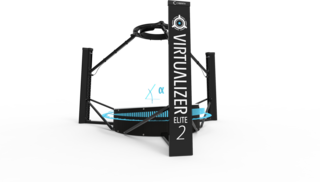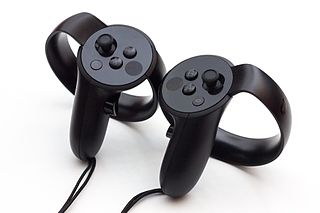
Virtual reality (VR) is a simulated experience that employs pose tracking and 3D near-eye displays to give the user an immersive feel of a virtual world. Applications of virtual reality include entertainment, education and business. Other distinct types of VR-style technology include augmented reality and mixed reality, sometimes referred to as extended reality or XR, although definitions are currently changing due to the nascence of the industry.

An omnidirectional treadmill (ODT) is a mechanical device, similar to a typical treadmill, that allows a person to perform locomotive motion in any direction, allowing for 360 degrees of movement. The ability to move in any direction is how these treadmills differ from their basic counterparts.

VirtuSphere is a spherical virtual reality device. It consists of a 10-foot hollow sphere, which is placed on a special platform that allows the sphere to rotate freely in any direction according to the user’s steps. It works with computer based simulations and virtual worlds, and rotates as the user walks, allowing for an unlimited plane upon which the user can walk. A wireless head-mounted display with gyroscopes is used to both track the user's head movement as well as display the environment of the virtual world. VirtuSphere can serve many purposes, including exercise, video gaming, military training, and virtual museum tours.

360-degree videos, also known as surround video, or immersive videos or spherical videos, are video recordings where a view in every direction is recorded at the same time, shot using an omnidirectional camera or a collection of cameras. The term 360x180 can be used to indicate 360° of azimuth and 180° from nadir to zenith. During playback on normal flat display the viewer has control of the viewing direction like a panorama. It can also be played on a display or projectors arranged in a sphere or some part of a sphere.

Immersion into virtual reality (VR) is a perception of being physically present in a non-physical world. The perception is created by surrounding the user of the VR system in images, sound or other stimuli that provide an engrossing total environment.

Oculus Rift is a discontinued line of virtual reality headsets developed and manufactured by Oculus VR, a virtual reality company founded by Palmer Luckey that is widely credited with reviving the virtual reality industry. It was the first virtual reality headset to provide a realistic experience at an accessible price, utilizing novel technology to increase quality and reduce cost by orders of magnitude compared to earlier systems. The first headset in the line was the Oculus Rift DK1, released on March 28, 2013. The last was the Oculus Rift S, discontinued in April 2021.

The Virtuix Omni is an omnidirectional treadmill simulator for virtual reality games and other applications. It uses a platform to simulate locomotion i.e. the motion of walking, requiring both special shoes or shoe covers and a surface that reduces friction. It works in conjunction with the HTC Vive, and allows a Vive user to physically walk within a limited number of supported games.

The Virtualizer is a series of omnidirectional treadmills for virtual reality applications. The treadmills have integrated sensors for motion detection of the user. The products are being developed, manufactured and sold by the Austrian company Cyberith GmbH.

Reality Labs is a business and research unit of Meta Platforms that produces virtual reality (VR) and augmented reality (AR) hardware and software, including virtual reality headsets such as Quest, and online platforms such as Horizon Worlds. In June 2022, several artificial intelligence (AI) initiatives that were previously a part of Meta AI were transitioned to Reality Labs. This also includes Meta's fundamental AI Research laboratory FAIR which is now part of the Reality Labs - Research (RLR) division.
Virtual reality sickness occurs when exposure to a virtual environment causes symptoms that are similar to motion sickness symptoms. The most common symptoms are general discomfort, eye strain, headache, stomach awareness, nausea, vomiting, pallor, sweating, fatigue, drowsiness, disorientation, and apathy. Other symptoms include postural instability and retching. Common causes are low frame rate, input lag, and the vergence-accommodation-conflict.

Oculus Touch is a line of motion controller systems used by Meta Platforms virtual reality headsets. The controller was first introduced in 2016 as a standalone accessory for the Oculus Rift CV1, and began to be bundled with the headset and all future Oculus products beginning in July 2017. Since their original release, Touch controllers have undergone revisions for later generations of Oculus/Meta hardware, including a switch to inside-out tracking, and other design changes.

A virtual reality headset is a head-mounted device that provides virtual reality for the wearer. VR headsets are widely used with VR video games but they are also used in other applications, including simulators and trainers. VR headsets typically include a stereoscopic display, stereo sound, and sensors like accelerometers and gyroscopes for tracking the pose of the user's head to match the orientation of the virtual camera with the user's eye positions in the real world.
Tilt Brush is a room-scale 3D-painting virtual-reality application available from Google, originally developed by Skillman & Hackett.

Daydream is a discontinued virtual reality (VR) platform which was developed by Google, primarily for use with a headset into which a smartphone is inserted. It is available for select phones running the Android mobile operating system that meet the platform's software and hardware requirements. Daydream was announced at the Google I/O developer conference in May 2016, and the first headset, the Daydream View, was released on November 10, 2016. To use the platform, users place their phone into the back of a headset, run Daydream-compatible mobile apps, and view content through the viewer's lenses.
Foveated rendering is a rendering technique which uses an eye tracker integrated with a virtual reality headset to reduce the rendering workload by greatly reducing the image quality in the peripheral vision.

A virtual reality game or VR games is a video game played on virtual reality (VR) hardware. Most VR games are based on player immersion, typically through head-mounted display unit or headset with stereoscopic displays and one or more controllers.

Rec Room is a virtual reality massively multiplayer online game with an integrated game creation system, initially released in 2016. It is available on Microsoft Windows, Xbox One, Xbox Series X and Series S, PlayStation 4, PlayStation 5, PSVR, Meta Quest, Pico, iOS, and Android.
The Valve Index is a consumer virtual reality headset created and manufactured by Valve. Announced on April 30, 2019, the headset was released on June 28 of the same year. The Index is a second-generation headset and the first to be manufactured completely by Valve. Half-Life: Alyx is bundled in with the headset.

Oculus Rift CV1, also known simply as Oculus Rift, is a virtual reality headset developed by Oculus VR, a subsidiary of Meta Platforms, known at the time as Facebook Inc. It was announced in January 2016, and released in March the same year. The device constituted the first commercial release in the Oculus Rift lineup.

Meta Horizon Worlds is a free virtual reality, online video game with an integrated game creation system developed and published by Meta Platforms. On this multi-player virtual platform, players move and interact with each other in various worlds that host events, games, and social activities. The game works on Oculus Rift S, Meta Quest 2, Meta Quest Pro and Meta Quest 3 headsets.















